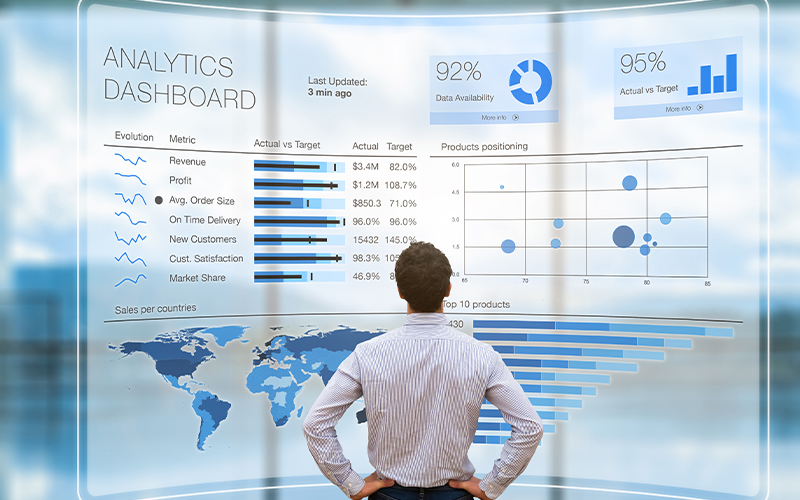BPM Analytics
Automation and Analytics critical to the transformation of risk management from reactive to predictive
Risk is not one-dimensional. This has especially been evident during the pandemic when businesses faced disruptions that cascaded down to vendors, the logistics networks and even end-consumers. What impacted a service provider on one end of the world, affected partners on the other side of the world as well. The volatility continues with climate change, wars, political uncertainties and other threats continuing to impact how the world functions. Thus, cascading risks will continue to affect businesses now and in the future.
In order to survive and thrive, businesses can no longer rely on traditional risk management which operates in silos within each business department. Companies are taking a fresh look at their risk management processes and are looking for a robust and holistic enterprise risk management program which not only looks at a long-term strategic view of the kinds of risks that could hurt an organisation but also be able to identify early indicators of risks and be proactive in their mitigation. The approach, therefore, needs to transform from risk management to risk-enabled performance management (REPM) which means that the focus will now be on mapping the critical business drivers to emerging risks and creating metrics for effective monitoring.
There is an increased interest in a risk management program that supports sustainability and improves enterprise agility* as well, by combining the capabilities of automation, analytics, and artificial intelligence.
Automation opens up new possibilities
Automation of risk management tasks and processes opens new possibilities for risk management teams and organisations in general, helping them automate monotonous processes and reporting systems and freeing up time for value added tasks like high-risk mitigation.
However, are executives ready for this? According to EY, 69% of businesses would like to increase their investment in data and technology for risk management in the next one year. It is one of the top priorities for the boards of organisations. However, there are two main obstacles – lack of skills required to use the data, technology, and analytics to determine and mitigate risk, and the fact that most teams continue to be reactive to risk, requiring a change in mindset. On the other hand, companies that are already leveraging data and technology are finding it difficult to unify data sets from the different sources to make risk measurement and mitigation more holistic and forward thinking.
Thus, embracing automation, analytics and AI is the only solution to the otherwise heavy regulatory load that will hinder efficient functioning and growth of businesses, not to mention disruption of business.
Leave the monotonous tasks to automation and AI, and focus on high end mitigation
By using big data and automation companies can improve the efficiency and cost effectiveness of their risk management process. A recent study by Forrester revealed that there was a 361% increase in the total ROI derived from the automation of the risk management process.
Data collection can be done through Robotic Process Automation (RPA) tools. Machine Learning and AI is used to perform sentiment analysis and impact analysis to understand where the event poses a threat to the organisation and what could be the potential impact.
Automation and AI also frees human resources from spending many hours just gathering and validating data. Not only that, but risk actions can also be automated to a large extent when they are programmed into the system based on risk appetite, tolerance, thresholds and risk scores, and data is validated and processed using automation and AI. Only those that require the highest mitigation process then need human intervention.
A good example would be the possibility of improving SEC filings which is a very manual process. Today, technology has made it possible to automate the filings and provide accurate reporting. Internal audits are another area which has always been a labour-intensive process prone to human error. A process which requires sifting through huge amounts of data, is now being performed by artificial intelligence.
McKinsey, in its recent report also observed that financial services companies have taken a lead in using technologies like automation and AI in risk management. For example, banks are relying more and more on fast computing power that allows risk functions to use all forms of customer information to enable them to make better credit risk decisions, keep an eye out for early signs of problems in portfolios, identify any financial crimes early and thus predict and avert losses.
Other areas that big data and automation can help in market risk analysis are: Fraud management, credit management, money laundering, market and commercial loans, etc.
Every aspect of the risk management process could benefit through analytics
The use of analytics comes into play when these technologies use statistical models to improve the accuracy with which risks can be detected and predicted, thus improving the visibility of the organisation into its risk exposure. Analytics technologies need to be embedded across the entire risk management process, ranging from detection to measurement to mitigation to monitoring.
A report by Markets and Markets which estimates that the global risk analytics market size is set to grow from USD 39.3 billion in 2022 to USD 70.5 billion by 2027 at a rate of 12.4% CAGR seems to echo this sentiment.
Using Business Intelligence tools like web scrapers, data ingestion tools, visualisation platforms, data models, AI/ML models, scenario models, workflow tools and others, analytics helps take the guesswork out by calculating scenarios, extrapolating insights and then predicting future events. Analytics uses the organisations’ access to a wide range of structured and unstructured data – such as websites, social media, blogs and internal data to integrate it into a single, unified view to gather information and enable actionable insights.
Conclusion
There has not been a time when risk management has been more important. The rapid pace of globalisation, climate change, disruptive use of technologies to change business models, rise of pandemics all point to the need to predict and address risks before they occur. Automation, AI, and analytics is the key to being able to do that. Apart from automating core business processes and making analytics technology investments, there needs to be a shift in the culture which prioritises risk management and develops key analytics skills of the staff.
* For organizations on the digital transformation journey, agility is key in responding to a rapidly changing technology and business landscape. Now more than ever, it is crucial to deliver and exceed on organizational expectations with a robust digital mindset backed by innovation. Enabling businesses to sense, learn, respond, and evolve like a living organism, will be imperative for business excellence going forward. A comprehensive, yet modular suite of services is doing exactly that. Equipping organizations with intuitive decision-making automatically at scale, actionable insights based on real-time solutions, anytime/anywhere experience, and in-depth data visibility across functions leading to hyper-productivity, Live Enterprise is building connected organizations that are innovating collaboratively for the future.






